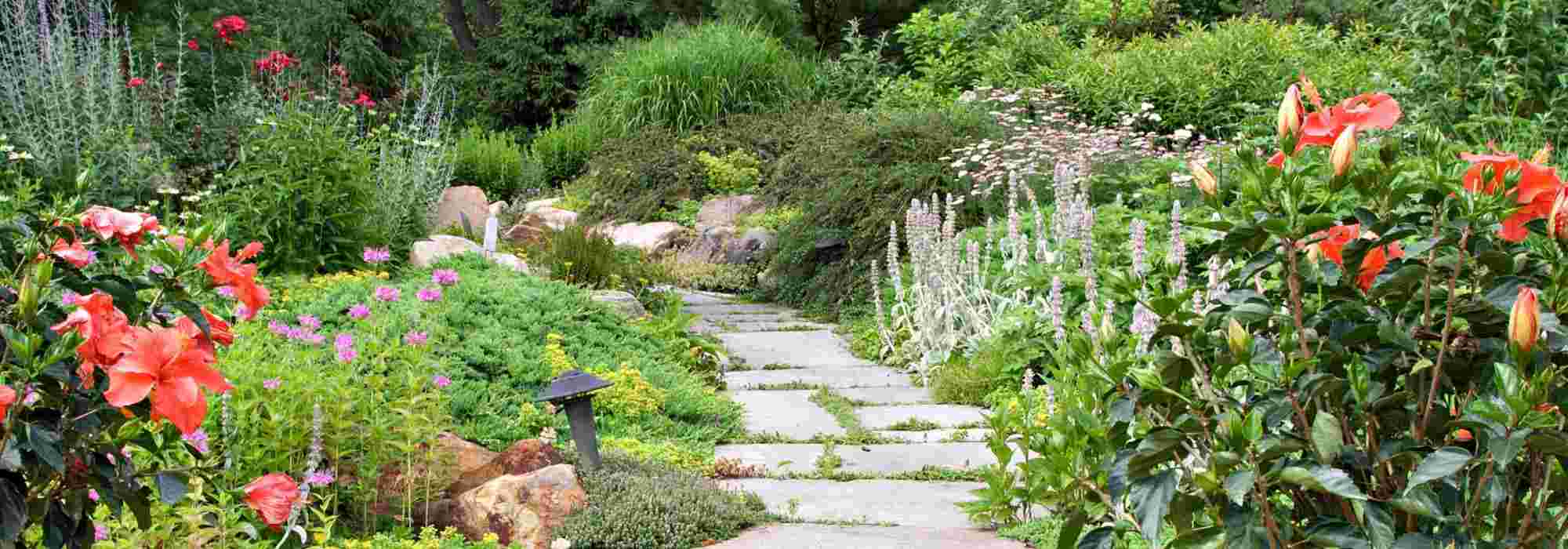
Different garden styles
The main types
Contents
As a means of expression, a garden reflects a country’s culture. Its flora highlights the climate that hosts it, its materials reveal soil composition and layout, and its design expresses the effect desired by its fortunate owner. Thus, across the world there are many varied garden styles, as dazzling as they are inspiring. Modern gardens, French, English, Japanese, exotic, Mediterranean… Discover different garden styles and their characteristics!
Modern garden
Modern gardens feature a clean, geometric style. Considered a true living space, a modern garden is divided into several functional areas, much like a house’s interior. Most of the time, it has a large terrace at the base of the house. It can be wood, a timeless material, or made of large slabs. Resolutely contemporary, some are even designed in polished concrete.
Like all gardens, the modern garden includes beds! They are intended to be contrasting, playing on different habits and textures. Structured plants, such as ball-shaped boxwood and ornamental allium, are paired with more flexible, airy specimens, like grasses. Stipa and Miscanthus are often found, as well as Deschampsia and Muhlenbergia capillaris. Contemporary gardens also allow hydrangeas, ferns, gauras and lavenders, mixing flowers and ornamental leaves. It is possible to play with a very wide plant palette, provided beds are well drawn and structured. Rectilinear in shape, they surround garden, paths and terrace…
To move from one area to another, it is common for paths to combine different materials. For example, concrete slabs with grassed joints, or gravel. Or wood slats with aluminium edging. The modern garden features small points of water. Narrow basins acting as water mirrors, channels that run down steps, fountains with a sleek design.
Dining area, garden lounge, pool, play spaces… The modern garden plays with levels to organise these different living areas. They are separated by beds, borders, low walls and steps. All elements of structure and decoration. Short grass meadow is also very present, regularly maintained to be green and well-mown. The advantage of this type of garden is that it can be created anywhere! They suit bungalows and modern houses, but will only enhance an older building.
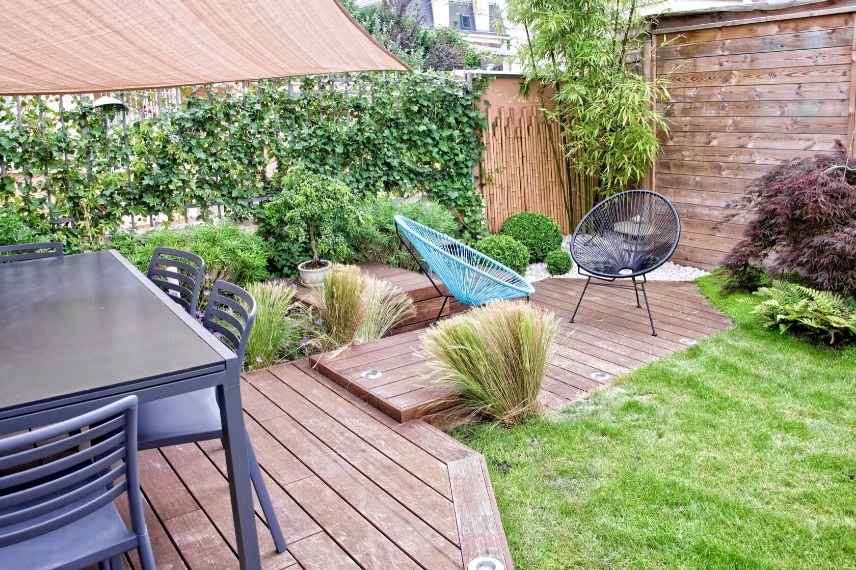
Modern or contemporary garden
Further reading on the subject:
Read also
How to landscape an English garden?French formal garden
Grandiose, theatrical, geometric, the French formal garden showcases man’s ability to master nature. It consists of embroidered parterres, large basins, trees in alignment, plants pruned into topiary, wide paths and well-mown short grass meadows. Some gardens include a maze, adding a playful element to the visit. Water is naturally very prominent since it symbolises wealth. Basins come in all shapes: sometimes round, square, rectangular… They are often fitted with jets of water to underline that majestic dimension.
As for plants, boxwoods are commonly used, as they lend themselves well to pruning. With spread of box tree moth in France, some prefer to replace them with yews, hornbeams, junipers, laurels or privets. One also finds citrus trees in orangeries, and flower beds made up of carnations, santolinas and begonias.
Although French formal garden is a frequent feature of châteaux, you can absolutely take inspiration from it! You can start by laying out straight paths in gravel or stabilised sand. Opt for areas of short grass meadow, mown regularly. Consider installing a water feature to bring that little spectacular touch typical of French gardens. This could be a fountain or a basin; ideally place it centrally. All that remains is to plant a bed of annuals, edged with a well-pruned dwarf honeysuckle border.
If your garden slopes, why not create terraces? It’s a good way to structure different garden areas. The first level can host a living space with a stone terrace for an authentic look. The second, a basin, and the third, plantings. A central staircase, flanked by trees in alignment, will give that “French touch” to this sloping garden.
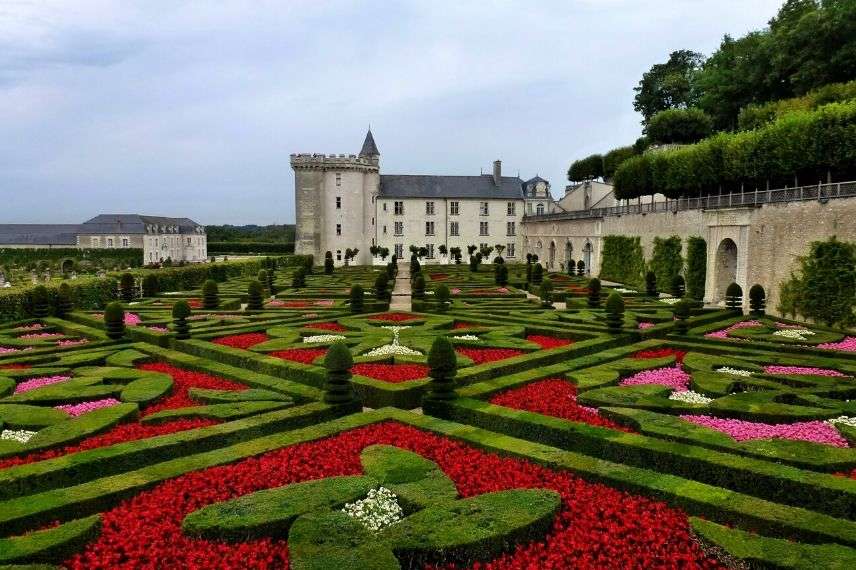
Example of French formal garden
English garden
It is often contrasted with French garden because it emphasises nature’s wilder side. Yet it is just as studied and maintained! The idea is to feel at the heart of a natural, picturesque and romantic landscape. To achieve this, curved lines are favoured! Paths are sinuous and borders have irregular edges to blur and soften contours. One of the signature elements of the English garden is the mixed-borders. These wide borders of perennials, annuals, roses and bushes play an important role. As their name suggests, they sit at sides of garden. This helps to blend garden boundary with landscape beyond.
Within these borders, silhouettes, colours and densities are mixed. The aim is to pair plants with an upright habit with bushier or more supple ones. To create a good border, in general it is better to put smaller plants in front and taller ones behind! Except for plants through which the eye easily passes, such as Buenos Aires verbena. So, for the background, plant bushes, climbing plants and tall perennials! If border is close to a wall, you will find clematis or jasmines to dress the back nicely. Depending on variety, clematis flowers between February and November and offers a multitude of colours. Otherwise, nothing beats a bushy shrub to structure the border and contrast with suppleness of perennials. Cotinus coggygria will bring that rounded effect, enhanced by airy flowering from May to September. Its foliage is green in spring before turning purple in summer and orange in autumn. Still at back of border, opt for foxgloves; these large flowers can reach 2 m in height. Next, choose lower-growing varieties such as irises, alliums or tulips. Also consider shrub and bush roses accompanied by long spikes of veronicas or persicarias, handsome campanulate, peach-leaved bellflowers or oriental poppies towards middle of border. In foreground, favour bergenias (bear’s ears), lower bellflowers or sedum. This type of garden suits both small urban gardens and large estates. Borders will be most work-intensive: annuals must be replanted each year and bushes pruned. But what a joy to see this mix of flowering from spring!
For rest of garden, install lawned areas, summerhouses, pergolas filled with trailing roses, wooden or stone fences, benches and garden furniture in wood or wrought iron. Larger gardens can afford a belvedere and a pond with a natural look for a so British style!
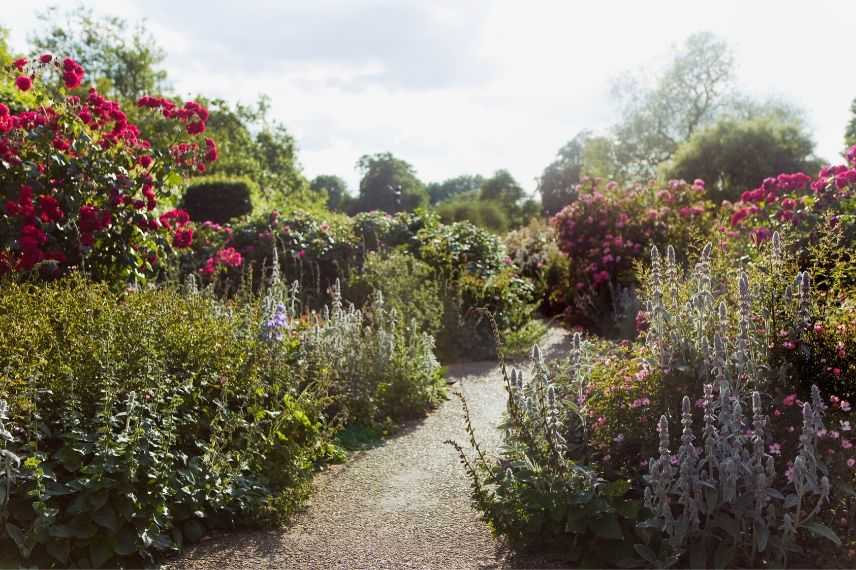
Example of English garden
Further reading on this topic:
Read also
Create a Japanese or Zen gardenJapanese garden
Japanese garden seeks to recreate a natural landscape in miniature. Between mineral and plant, this type of garden is extremely meticulous, arranged down to the millimetre. Advantage of Japanese garden is that it is ideally suited to small outdoor spaces.
Most of the time, paths are sinuate and planting beds do not reveal entire garden, making it appear larger. Japanese garden highlights organic shapes found in nature. For example, stepping stones have irregular contours, unlike those in modern gardens, which are often rectangular.
To compose planting beds, Japanese favour odd numbers. Plantings are not aligned but appear randomly placed, reinforcing natural aspect. Beds are made up of ericaceous plants. Azaleas, rhododendrons and magnolias reveal glossy, dark foliage, contrasted by bright, luminous flowers. Of course, star of Japanese gardens is none other than the Japanese maple. Preferring semi-shade exposure and humus-bearing, cool, free-draining soil, this small tree is prized for its decorative foliage. Sometimes palmate or finely incised, leaves range from purple to green. It is in autumn that they transform garden by displaying a wide coppery palette. To add a zen touch, consider bamboo: tall to screen back of garden, dwarf to define a path, or medium-sized at edge of a terrace, bamboo are among signature plants of the Japanese garden. Another expression of Japanese gardening precision: cloud-pruned trees and bushes. Among favoured species are yew, box and holly.
Japanese garden is highly decorated. Packed with spiritual symbols, it features sculptures, fountains, rocks, raked gravel and lanterns. For an elegant look, choose noble materials for these decorations, such as stone or wood. When garden size allows, a pond is installed, edged with rocks. A few Koi carp create ripples, while stepping stones or coloured bridges allow crossing. Between gravel paths and beds, wide spaces covered with helxine or lawn follow gentle undulations, like miniature hills.
This type of garden requires regular and rigorous maintenance. Be comfortable with gardening or call on a landscaper to maintain your beautiful planted compositions. Japanese gardens suit shaded areas! If garden faces north, take inspiration from Japanese plant palette.
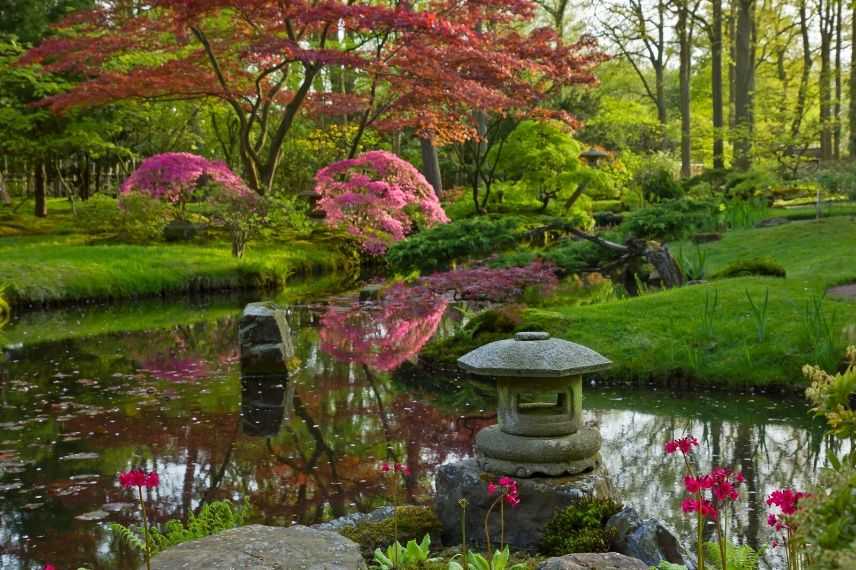
Example of Japanese garden
To read on the subject:
Exotic garden
Large foliage, exuberant flowers: exotic garden truly offers a change of scene. It evokes both tropical forests and arid deserts that harbour botanical curiosities. Although most of these plants do not grow at our latitudes, some species are hardy and can be cultivated in France. One of the most widespread is Trachycarpus fortunei! With crowns of fan-shaped leaves, it withstands down to -18°C thanks to its stipe covered with interlaced fibres. Reaching up to 10 m, it can be planted as a specimen or at the back of a bed. Exotic gardens often host banana plants, with their XXL leaves. Musa basjoo can even tolerate down to -15°C (for short periods)! Among other large-leaved species are ferns (arborescent or not), hostas, and even the famous Brazilian rhubarb.
Beds are also enlivened by beautiful flowerings, such as those of Canna or bird of paradise. Canna flowers, yellow, red or orange, appear in summer, while birds of paradise reveal their colourful, bird-like blooms from June to October. This plant palette evokes a tropical, humid climate, but exotic garden can be quite different! Indeed, cacti and succulents represent an arid climate, with a very different appearance. These dry beds are often covered with gravel and have the advantage of being easy to maintain. While several tropical (or tropical-looking) plants withstand our winters, to plant a bed of cacti and succulents you need light, even poor, well-drained soil and a mild winter climate.
Beyond plants, exotic garden is colourful! Walls are more easily painted than in Western gardens and display bright colours (red, orange, blue, pink, yellow). There is no short grass meadow; emphasis is on the beds! Rest of garden is made up of mineral or wooden paths. This type of garden suits sloping terrain well, which is traversed by steps. Rest areas are arranged and covered by shade sails or parasols. Under blazing heat, exotic gardens are adorned with welcome water features. They take the form of ponds hosting aquatic plants, channels or outdoor showers. Different fittings can be mineral or made of tropical woods. Ipe, mahogany or teak are rot-proof and offer warm tones.
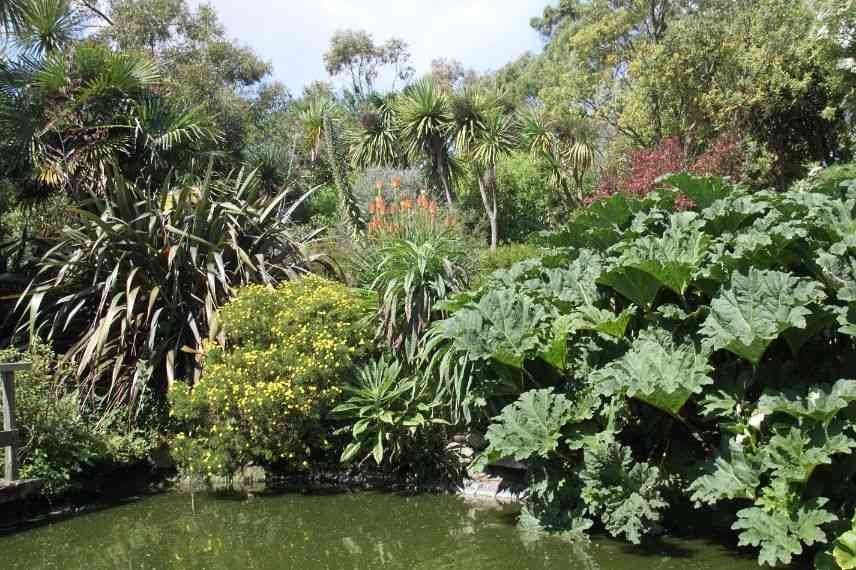
Example of exotic garden (Roscoff, Brittany)
Further reading on the subject:
- 10 hardy plants for an exotic dry garden
- 10 exotic and hardy plants for jungle garden
Mediterranean garden
The Mediterranean garden enjoys a mild climate all year round, which allows it to host a beautiful dry-soil flora. When picturing a Mediterranean garden, one imagines a sloping garden, with beds held by restanques (dry-stone retaining walls), plunging straight towards the sea. Indeed, this type of garden does not include a short grass meadow, which would very quickly dry out. Beds, paths and terraces therefore take on greater importance. Paths are wide, mineral in character and lined with rows of trees. Cypresses, umbrella pines and olive trees are the three most common subjects. Paths are often paved with stone, gravel or stabilised sand.
Low walls and hedges benefit from striking flowerings, such as bougainvillea, strawberry tree or oleander. Within rockery beds, you can spot lavenders, thyme, Helichrysum and santolinas. Succulents then intermingle, such as opulent agaves and Delosperma that carpet the soil. At the base of plants, gravel and rocks dress planted areas. If garden sits above sea level, a terrace is commonly created at the highest point. From there the whole garden unfolds with sea or landscape as a backdrop. To cool that arid atmosphere, Mediterranean gardens include water channels, stone ponds and fountains, not without recalling a certain Italian influence.
Thanks to a mild climate, Mediterranean gardens are living spaces. An outdoor kitchen allows enjoying the garden for much of the year. It would be a shame to miss warm summer evenings. Lights, festoon lighting and other LEDs illuminate terraces and garden paths. Within the beds, they showcase plants and create a hushed atmosphere. As the name suggests, the Mediterranean garden is laid out around the Mediterranean basin. However, other coastal areas, such as south-west France, can accommodate most plants typical of this garden type.
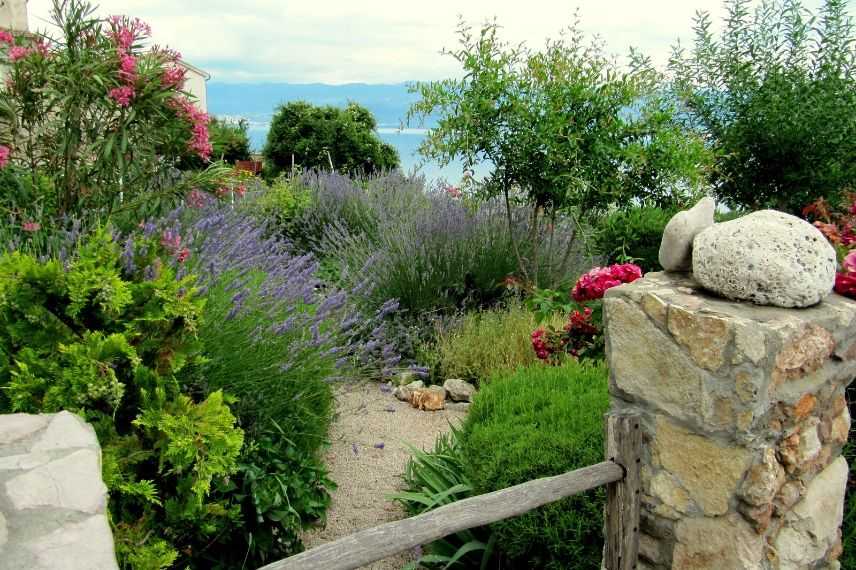
Mediterranean garden example
Further reading on the subject :
Naturalistic garden
Naturalistic garden is a return to roots, a connection to nature in its most spontaneous form. This type of outdoor space is a refugium within ever-expanding urbanisation. Hardy plants, long flowering and striking senescences, perennials and grasses mingle to create meadows that look as if they have always been there. Naturalistic garden evokes countryside and walks in fields. However, it remains a garden designed and thought through before planting. This is the case of the Piet Oudolf Garden in Hummelo or the famous Jardin Plume.
To lay out a naturalistic garden, allocate a large portion of garden to planting beds, at least half of garden area. For this, combine wild perennials such as Echinacea, Knautia or sages. Growing naturally in meadow, Echinacea tolerate sun and drought well, while producing their wildflower-like blooms from July to September. Knautia is distinguished by silvery foliage, bushy habit and small red pompom flowers from June to September. During same period, Salvia nemorosa ‘Amethyst’, an easy-to-grow woodland sage, reveals mauve flowers in spikes. You can then pair these field perennials with grasses! Consider Calamagrostis acutiflora ‘Karl Foerster’. Its habit is slender and upright; its green, flexible leaves are topped with erect golden plumes. It pairs beautifully with Miscanthus, such as Miscanthus sinensis ‘China’ with its coppery spikes. In dry soil, you can also combine wild side of Briza maxima, whose stems bear drooping, heart-shaped spikelets. This grass, ideal for dried bouquets, self-seeds freely when left to its own devices. These large, flowing, natural planting beds can be edged by well-trimmed hedges. Structure and suppleness then combine to form a beautiful contrast. These yew or privet hedges delimit different planted areas and only enhance palette of wild plants. Do not hesitate to add a water feature, such as a small pond. Surmounted by a wooden footbridge, a pond edged with Carex and Phragmites will take on appearance of a natural pool. Between planting beds, allow wide paths of short grass meadow and place some furniture here and there to fully enjoy garden.
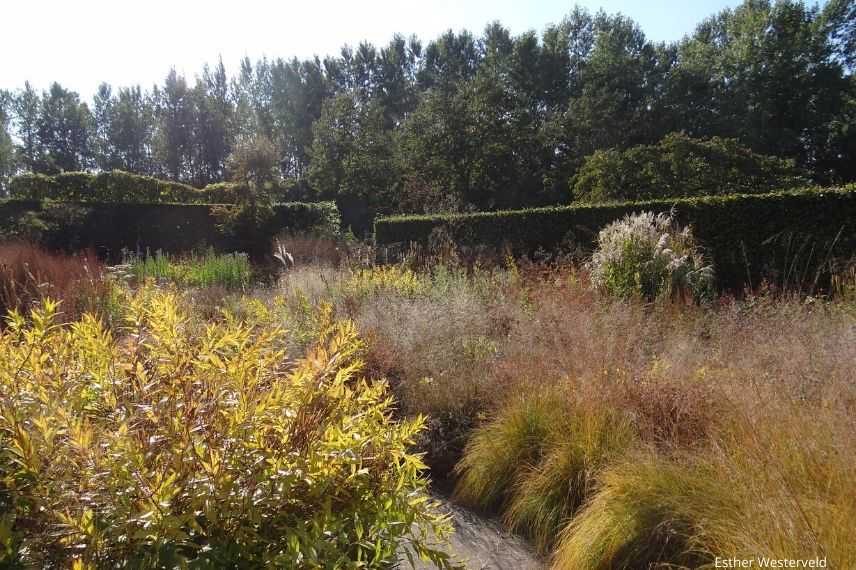
Example of naturalistic garden (Hummelo, Netherlands)
- Subscribe!
- Contents
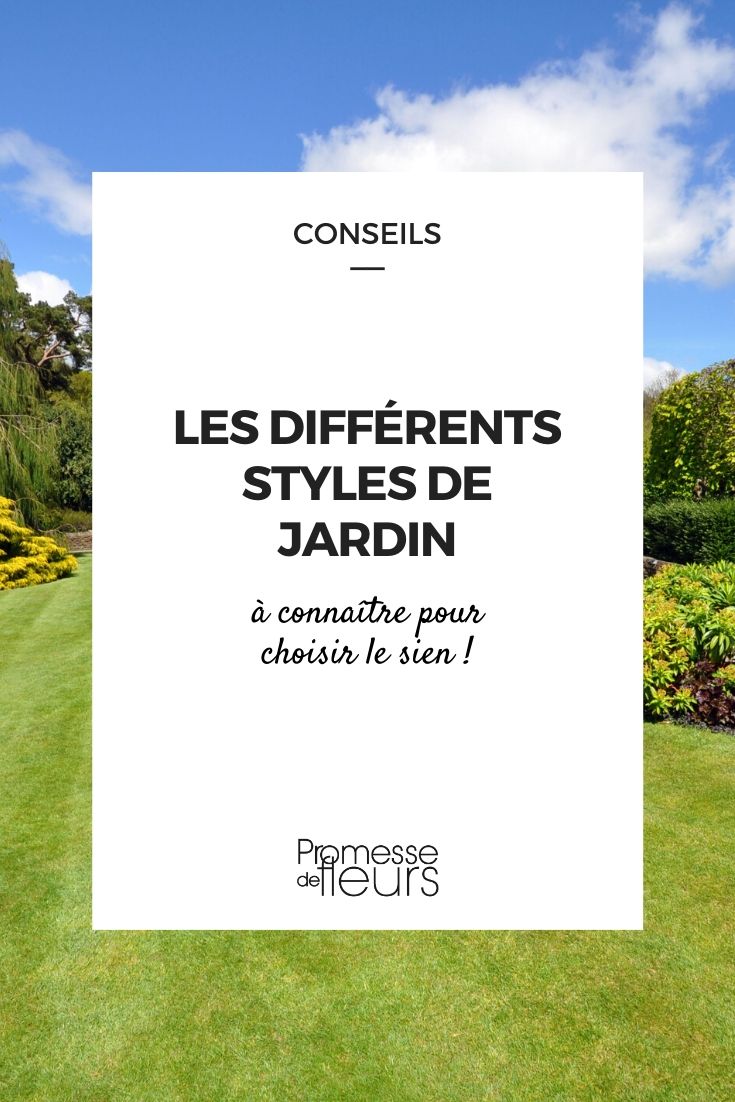































Comments